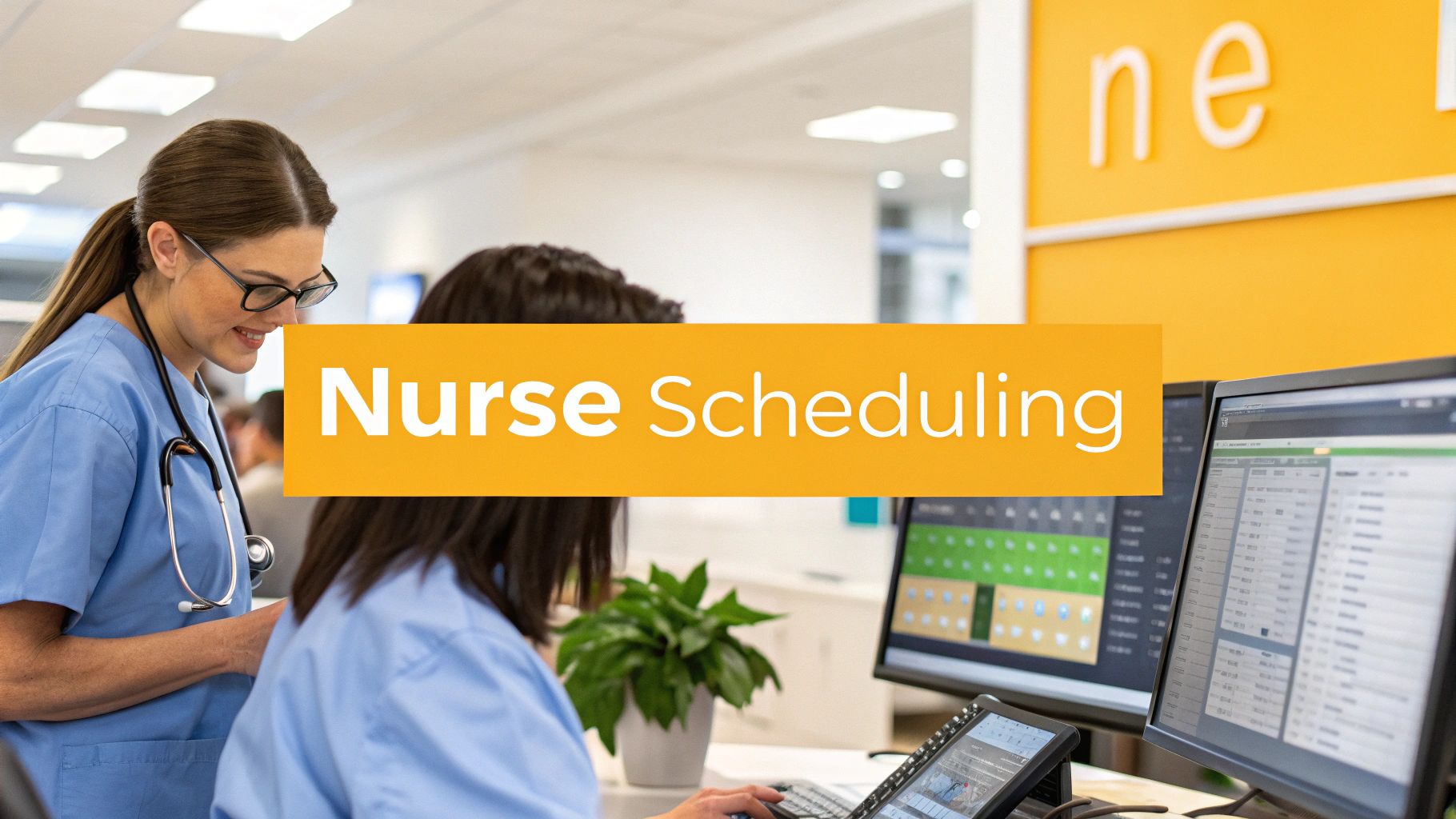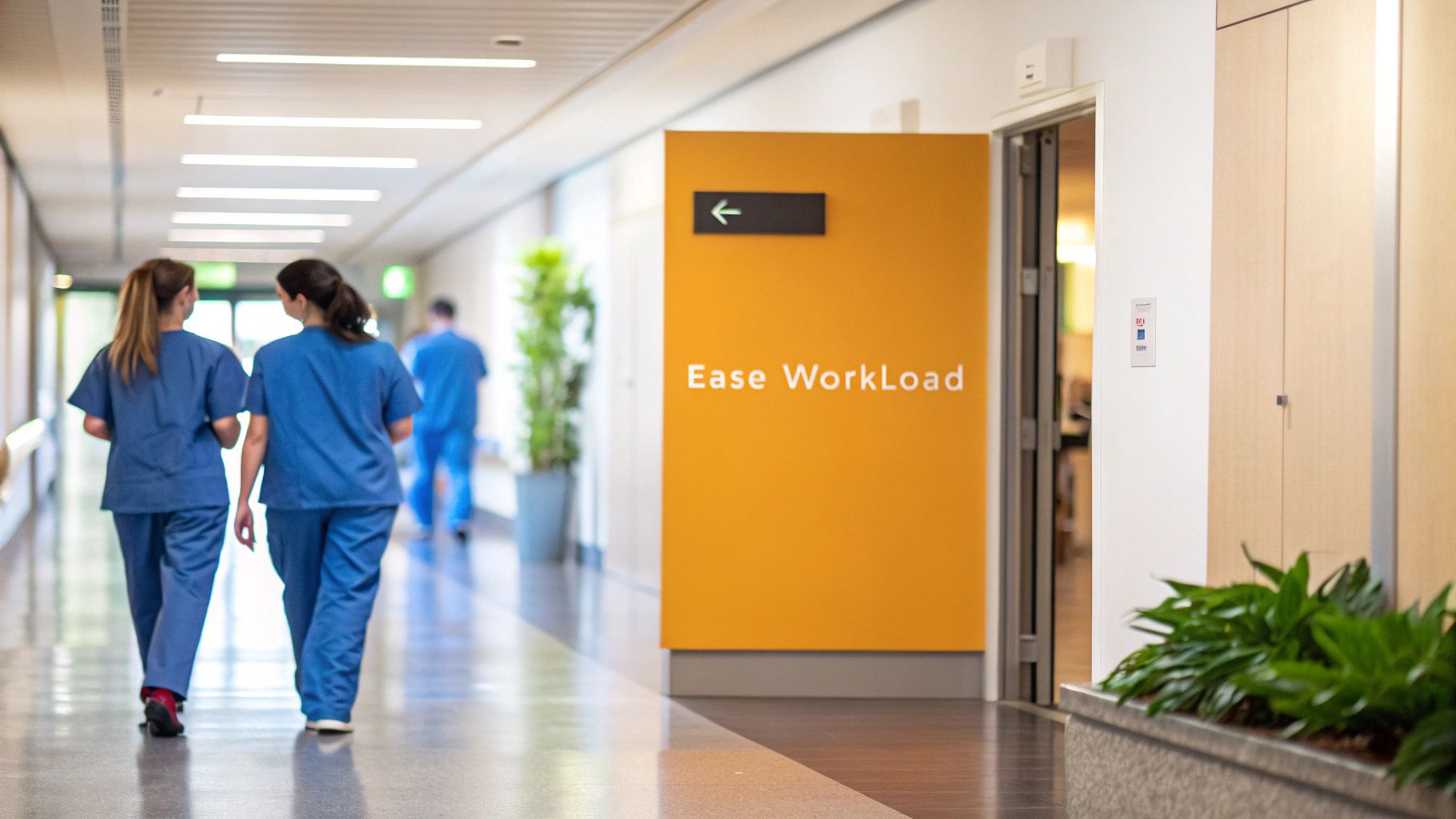From our resource library for organizational scheduling and management.
Nurse Scheduling Software: A Complete Guide to Streamlining Healthcare Workforce Management

Why Nurse Scheduling Software Is Transforming Healthcare Management

Managing nursing staff schedules has become increasingly complex with fluctuating patient volumes, diverse staff needs, and strict regulations. Healthcare facilities are turning to specialized scheduling software as an essential tool to handle these challenges effectively. This technology helps managers move beyond manual scheduling to create more efficient and balanced work rosters.
Gone are the days of wrestling with spreadsheets and endless phone calls. Modern scheduling platforms let managers quickly create schedules that work for both the facility and its nurses. This frees up valuable time that can be redirected to patient care and other essential duties. Want to learn more? Check out this guide on how to master nurse rostering software.
Addressing Key Pain Points in Healthcare
The software directly tackles major challenges like staff shortages by making the best use of available resources. When schedules are optimized, nurses are less likely to face burnout, which improves team morale. These tools also ensure schedules follow all required regulations and union agreements, helping facilities avoid costly compliance issues.
Quick schedule adjustments are another key benefit. In healthcare, unexpected staff absences and sudden increases in patient numbers are common. Being able to quickly update schedules helps maintain proper coverage and quality care during these situations. The result? Better patient experiences and improved care outcomes.
The Growing Market for Nurse Scheduling Solutions
The numbers tell a clear story about the value of these scheduling tools. The nurse scheduling software market reached $318.48 million in 2023. Experts predict it will grow to $982.3 million by 2031, with a yearly growth rate of 13.4%. These figures show how essential these tools have become in modern healthcare. See the full market analysis here: Nurse Scheduling Software Market Research.
Smart scheduling software does more than just arrange work hours - it's a vital tool for running an effective healthcare facility. By handling complex scheduling tasks automatically, these systems help healthcare providers focus on what matters most: delivering quality patient care. As healthcare continues to evolve, good scheduling tools will remain essential for managing staff effectively and maintaining high standards of care.
Essential Features That Drive Real Results

Good nursing scheduling software does more than just fill empty shifts. These tools help healthcare facilities run smoothly, keep staff happy, and provide better patient care. Let's look at the key features that make the biggest impact.
Automated Scheduling and Shift Optimization
The core function of scheduling software is smart automation. The system considers each nurse's availability and skills, along with department needs, to create workable schedules. This frees up managers from hours of manual scheduling work. The software also helps prevent both understaffing and overstaffing by balancing workloads across shifts.
Self-Scheduling Options and Shift Swapping
Nurses appreciate having more control over their schedules. Self-scheduling lets them pick shifts that work best with their personal lives - like working several days in a row followed by a longer break. When plans change, built-in shift swap features make it simple to trade shifts with coworkers, without creating extra paperwork.
Real-Time Visibility and Mobile Access
Managers need to see staffing levels at a glance. Current scheduling tools show exactly who's working, who's off, and which shifts need coverage. This helps healthcare teams quickly adjust to unexpected changes. Mobile apps mean both nurses and managers can check schedules and make updates from anywhere.
Compliance Tracking and Reporting
Following labor laws and policies is essential in healthcare. Good scheduling software automatically tracks working hours, overtime, and required breaks. This helps prevent compliance issues while providing useful data. Managers can spot trends in staffing needs and make better budget decisions based on real numbers.
Integration with Existing Systems
The best scheduling tools work smoothly with other hospital software like HR and payroll systems. This removes the need to enter information multiple times and reduces mistakes. When systems share data automatically, it saves time and improves accuracy. For example, worked hours flow directly into payroll for correct paychecks. You might be interested in: The Complete Guide to Nursing Roster Software.
Advanced Analytics and Reporting
Data insights help make better staffing choices. The software analyzes patterns to show where scheduling bottlenecks happen and what drives overtime costs. Looking at past data helps predict future staffing needs based on expected patient numbers. This leads to smarter scheduling decisions and better use of resources.
When healthcare facilities use these key features well, they see real improvements. Staff morale goes up, scheduling gets easier, and patient care benefits. The right scheduling software makes a big difference in creating an efficient, positive work environment.
Making the Right Choice: Cloud vs. On-Premise Solutions

When selecting nursing scheduling software, one of the most important decisions is how you'll deploy it. The two main options are cloud-based and on-premise systems. Let's explore what each offers to help you make the best choice for your facility.
Cloud-Based Nursing Scheduling Software
Cloud solutions, also known as Software as a Service (SaaS), have become popular in healthcare settings. These systems run on the vendor's servers and staff access them through a web browser. This removes the need to buy and maintain expensive hardware.
Key benefits of cloud-based systems include:
- Access schedules from any device with internet access
- Easily scale up or down as your needs change
- Get automatic updates and security fixes
- Lower upfront costs with predictable monthly fees
But cloud systems do have some drawbacks to consider:
- Need reliable internet to access the system
- Less direct control over sensitive data
- May have fewer customization options
According to a recent nurse scheduling software market report, cloud-based solutions make up the largest portion of the market. Large hospitals often choose cloud systems because they handle high volumes of scheduling data well.
On-Premise Nursing Scheduling Software
On-premise solutions install directly on your facility's servers. This gives you more control over the system and your data.
Main advantages include:
- Full control over data security and storage
- More options to customize the software
- Can work without internet access
However, on-premise systems come with challenges:
- High initial costs for hardware and licenses
- Your team handles all maintenance and updates
- Need dedicated IT staff for support
Choosing the Right Deployment Model
Your choice between cloud and on-premise depends on your specific needs. Consider your budget, IT resources, security requirements, and how much customization you want.
For example, a small clinic might do better with a simple cloud system they can access anywhere. A major hospital system with strict data rules might prefer an on-premise solution they can fully control.
Take time to evaluate both options carefully. Consider how each model fits your scheduling needs and overall operations. This will help you pick the solution that works best for your facility.
Regional Success Stories and Implementation Insights
Modern healthcare facilities increasingly rely on nursing scheduling software to manage their complex staffing needs. Each region has its own workforce challenges and regulations to navigate. Real examples from hospitals and clinics show what works - and what doesn't - when putting these systems into practice.
North America's Leading Role in Nurse Scheduling Software Adoption
North American healthcare facilities have embraced nurse scheduling software more than any other region. Local hospitals face serious challenges like staff shortages and changing patient numbers throughout the day. The software helps manage complex shift patterns while ensuring compliance with labor laws and union agreements. Learn more details at Global Market Estimates.
Adapting to Regional Challenges: A Case Study Approach
Different facilities use the software in ways that fit their specific needs. Big city hospitals focus on managing peak hours and patient surges. Small rural clinics use it to handle on-call schedules and reduce their reliance on expensive temporary staff. These examples show how flexible the software can be.
Key Factors in Regional Success
These core elements help ensure good results with scheduling software:
- Strong Leadership Support: Having managers who actively champion the software helps staff embrace the change
- Thorough Staff Training: Teaching everyone how to use the system properly maximizes its value
- Regular Updates: Checking and adjusting settings as needs change keeps the system working well
Implementing with Regional Nuances in Mind
Each region requires a slightly different approach. Areas with strong unions need features that let staff participate in scheduling decisions. Places with diverse language needs might require multiple interface options. Success comes from understanding these local requirements.
Learning from Others: Best Practices and Lessons Learned
Real examples show what works best. One Midwest hospital connected their scheduling software to their payroll system, which saved time and reduced mistakes. A West Coast facility improved their on-call process and now responds faster to urgent staffing needs. These practical experiences help other facilities avoid common pitfalls and get better results from their scheduling software.
Your Blueprint for Successful Implementation
Getting started with nursing scheduling software might seem challenging at first. But with good planning and the right approach, you can make the switch smoothly. Let's look at the key steps that have worked well for other healthcare facilities.
Phase 1: Assessment and Planning
Start by taking a close look at how you currently handle scheduling. What problems do you face? Maybe you're dealing with too much overtime or struggling to fill unexpected shift gaps. Think about what you want to achieve - reducing costs, making staff happier, or staying on top of regulations. Your answers will help you pick the right software solution.
Phase 2: Vendor Selection
Take your time choosing a software provider. Compare different options by looking at their features, costs, and support services. Make sure they offer what you need - like automatic scheduling, options for staff to manage their shifts, and clear schedule tracking. See if the software can grow with your facility and work with your current systems. Ask for demos to test each option hands-on.
Phase 3: Implementation and Training
After picking your software, work with the provider to set everything up and move your scheduling data over. Create a solid training plan that covers all parts of the new system. Give your staff different ways to learn - through online guides, in-person classes, and quick reference sheets. Good training helps everyone adapt quickly and keeps operations running smoothly.
Phase 4: Go-Live and Support
When you start using the new software, make sure you're ready to help your staff. Have people available to answer questions and solve problems right away. Watch how the system performs and ask staff for feedback. Be ready to make changes to help everything work better.
Phase 5: Optimization and Evaluation
Once you're up and running, focus on making the system work its best. Look at your data to spot ways to improve. Keep track of important numbers like overtime costs and staff satisfaction. Regular check-ins help ensure your scheduling software keeps meeting your needs as they change.
Best Practices for Successful Implementation
- Get Everyone On Board: Include nurses, managers, and IT staff from the start to build support and make the transition easier
- Plan for Change: Help staff adjust by showing them how the new system will make their work better
- Keep Information Flowing: Stay in touch with everyone throughout the process and address concerns quickly
- Set Clear Timelines: Break the project into smaller steps with specific deadlines to track progress
- Test First: Try the system with a small group before rolling it out to everyone
Following these steps and practices helps ensure your new scheduling system works well for everyone. Remember to keep checking in and making improvements as you go - good implementation is an ongoing process that helps your facility run better and your staff work more effectively.
The Future of Nurse Scheduling: Emerging Technologies and Trends

As healthcare needs grow more complex, nurse scheduling is adapting through new tools and methods. Smart technologies are making it easier to create better schedules, keep staff happy, and deliver excellent patient care. Understanding these changes helps hospitals and clinics make informed decisions about their scheduling approach.
Artificial Intelligence and Machine Learning
AI and machine learning are bringing major improvements to nurse scheduling. These tools can process scheduling data to spot patterns and make smart predictions about staffing needs. They look at factors like staff availability, patient numbers, and past trends to suggest optimal schedules. The software can match nurses to shifts based on their skills and preferences, making the process smoother for everyone involved.
Predictive Analytics for Proactive Staffing
Using past data to plan future schedules helps avoid staffing problems before they happen. Predictive tools can spot times when you'll need more nurses, like during flu season or holiday periods. This means managers can adjust schedules early instead of making last-minute changes, helping maintain consistent care quality.
Automated Preference Matching and Self-Scheduling
Modern nursing scheduling software gives nurses more control over their work hours. The system matches nurses to shifts they prefer while considering their certifications and skills. Learn more in our article about healthcare staff scheduling software. Nurses can pick their shifts within set guidelines, creating better work-life balance and job satisfaction.
Integrations and Interoperability
Good scheduling software works smoothly with other hospital systems like HR, payroll, and patient records. When systems talk to each other, it cuts down on manual work and mistakes. For example, when a nurse works their shift, the hours automatically go to payroll for processing. This saves time and keeps records accurate.
Mobile Accessibility and Real-Time Updates
Mobile apps are essential for today's healthcare teams. Nurses can check schedules, request time off, and swap shifts right from their phones. Quick updates about schedule changes reach everyone instantly, which helps teams adjust quickly when someone calls out sick or patient numbers spike.
Ready to try a better way to schedule your nursing staff? Visit Acroroster to see how our solution can help and schedule a demo.